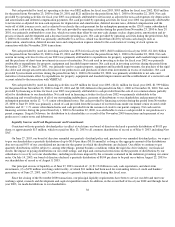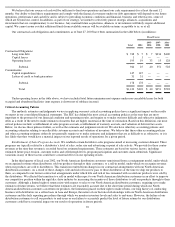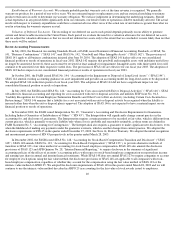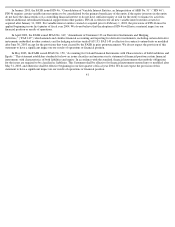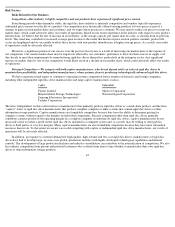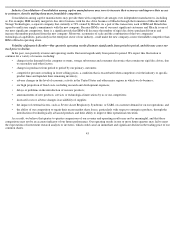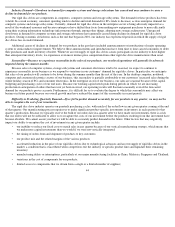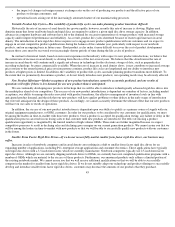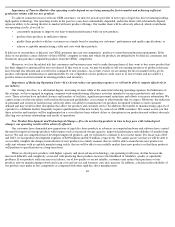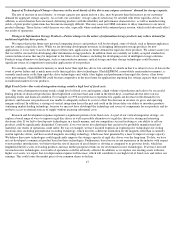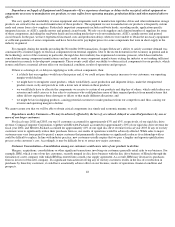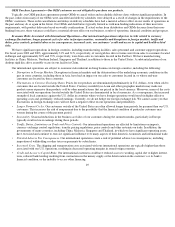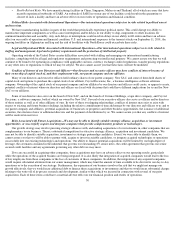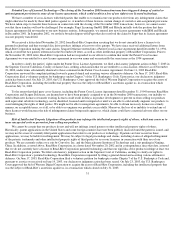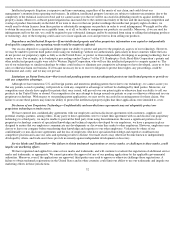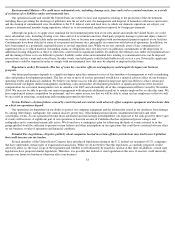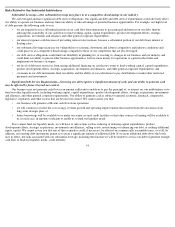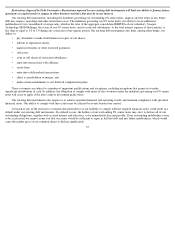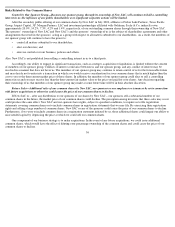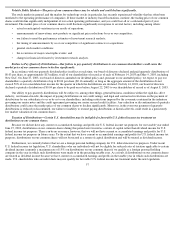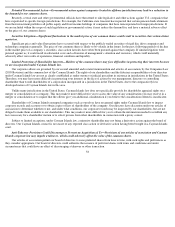Seagate 2002 Annual Report Download - page 53
Download and view the complete annual report
Please find page 53 of the 2002 Seagate annual report below. You can navigate through the pages in the report by either clicking on the pages listed below, or by using the keyword search tool below to find specific information within the annual report.
Dependence on Supply of Equipment and Components—If we experience shortages or delays in the receipt of critical equipment or
components necessary to manufacture our products, we may suffer lower operating margins, production delays and other material adverse
effects.
The cost, quality and availability of some equipment and components used to manufacture rigid disc drives and other information storage
products are critical to the successful manufacture of these products. The equipment we use to manufacture our products is frequently custom
made and comes from a few suppliers. Particularly important components include read/write heads, recording media, application-specific
integrated circuits, or ASICs, spindle motors and printed circuit boards. We rely on sole suppliers and a limited number of suppliers for some
of these components, including the read/write heads and recording media that we do not manufacture, ASICs, spindle motors and printed
circuit boards. In the past, we have experienced increased costs and production delays when we were unable to obtain the necessary equipment
or sufficient quantities of some components and have been forced to pay higher prices for some components that were in short supply in the
industry in general.
For example, during the months preceding the November 2000 transactions, Seagate Delaware’s ability to satisfy customer demand was
constrained by a limited supply of electrical components from external suppliers. Due to the recent downturn in the economy in general and in
the technology sector of the economy in particular, the rigid disc drive industry has experienced economic pressure, which has resulted in
consolidation among component manufacturers and may result in some component manufacturers exiting the industry or not making sufficient
investments in research to develop new components. These events could affect our ability to obtain critical components for our products, which
in turn could have a material adverse effect on our financial condition, results of operations and prospects.
If there is a shortage of, or delay in supplying us with, critical components, then:
•
it is likely that our suppliers would raise their prices and, if we could not pass these price increases to our customers, our operating
margin would decline;
•
we might have to reengineer some products, which would likely cause production and shipment delays, make the reengineered
products more costly and provide us with a lower rate of return on these products;
•
we would likely have to allocate the components we receive to certain of our products and ship less of others, which could reduce our
revenues and could cause us to lose sales to customers who could purchase more of their required products from manufacturers that
either did not experience these shortages or delays or that made different allocations; and
We cannot assure you that we will be able to obtain critical components in a timely and economic manner, or at all.
Dependence on Key Customers—We may be adversely affected by the loss of, or reduced, delayed or cancelled purchases by, one or
more of our larger customers.
•
we might be late in shipping products, causing potential customers to make purchases from our competitors and, thus, causing our
revenue and operating margin to decline.
For fiscal years 2002 and 2003, our top 10 customers accounted for approximately 63% and 63%, respectively, of our rigid disc drive
revenue. Compaq Computer Corporation, together with Hewlett-Packard, accounted for approximately 20% of our rigid disc drive revenue for
fiscal year 2002, and Hewlett-Packard accounted for approximately 18% of our rigid disc drive revenue for fiscal year 2003. If any of our key
customers were to significantly reduce their purchases from us, our results of operations would be adversely affected. While sales to major
customers may vary from period to period, a major customer that permanently discontinues or significantly reduces its relationship with us
could be difficult to replace. In line with industry practice, new customers usually require that we pass a lengthy and rigorous qualification
process at the customer’s cost. Accordingly, it may be difficult for us to attract new major customers.
Customer Concentration—Consolidation among our customers could cause sales of our products to decline.
Mergers, acquisitions, consolidations or other significant transactions involving our customers generally entail risks to our business. For
example, IBM, which is one of our key customers, recently merged its disc drive business with the disc drive business of Hitachi through the
formation of a new company with which IBM has entered into a multi-year supply agreement. As a result, IBM may decrease its purchases
from us in favor of this new company. If a significant transaction involving any of our key customers results in the loss of or reduction in
purchases by these key customers, it could have a materially adverse effect on our business, results of operations, financial condition and
prospects.
48


